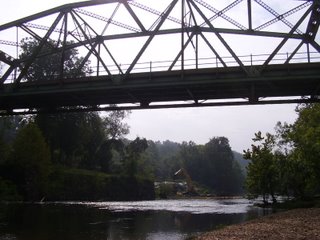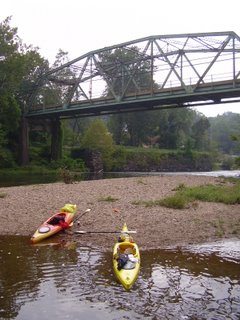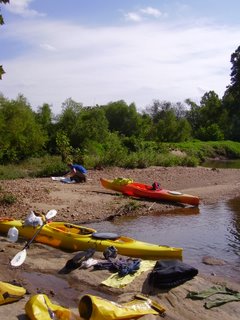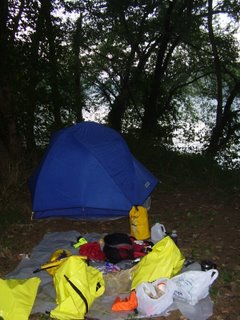Day 2: How to Drink Coffee From a Sports Bottle.
 We woke up a few hours after the butt crack of dawn to break down the camp and prepare our boats for our first long day. Day 2 found us leaving the Rivanna and entering the cavernous James River. About three miles from our camp we stopped in Palmyra to answer the call of nature at a conveniently located store where I scored a large bag of M&Ms and a cold Dr. Pepper. This stop would turn out to be the first, and only, time I would take a crap on the trip. That could have been a good thing, considering I did not have to tote a bucket of poop with me, but it ultimately led to problems for me on the last day. But I digress.
We woke up a few hours after the butt crack of dawn to break down the camp and prepare our boats for our first long day. Day 2 found us leaving the Rivanna and entering the cavernous James River. About three miles from our camp we stopped in Palmyra to answer the call of nature at a conveniently located store where I scored a large bag of M&Ms and a cold Dr. Pepper. This stop would turn out to be the first, and only, time I would take a crap on the trip. That could have been a good thing, considering I did not have to tote a bucket of poop with me, but it ultimately led to problems for me on the last day. But I digress.
As I said in the Day 1 post, we searched for the other camp site that is marked on the map, but were unable to locate any such place in real life. We didn't need it, so it wasn't a problem. I'm adding this tid-bit in case someone else would rather pass the first spot and camp further down stream. Good luck finding it.
A new bridge is under construction in Palmyra. The construction crew seemed to be pleasantly entertained as we dropped off a small ledge in their work zone and headed down the peaceful Rivanna River. Reportedly, the new bridge will host a pedestrian and bike path to allow more convenient access into Palmyra. Sounds pretty good, we'll see how it turns out.
When we left the camp area this morning, a bunch of suds caught up to us that we passed the day before. The suds began to show up in the vicinity of Lake Monticello, then fizzled out later on during day 1. On the morning of day 2, I caught sight of some globs of foam that have been in the news recently along the James River. Before now, though, the foam has not been mentioned in the Rivanna River. Because of lighting, we were not able to get any decent photos of the foam. I will probably return to the area in a week or so to take some pictures and grab a couple of samples. Nobody is very sure about the source of the foam, or even what chemical properties are causing the phenomenon. It's still pollution, and I don't like pollution in my river. The foaming idiot causing this mess will be found and hopefully the river will not be too badly damaged.
On a better note, we did see our first bald eagle of the trip while on the Rivanna River! Unfortunately, we did not get any pictures. We also saw a couple of Osprey soaring above the trees, numerous ducks, tons of geese, a few kingfishers, heron, woodpeckers, and an unidentified mammal swimming in the water. Most likely, he was a groundhog since there were no signs of beaver in the area. The Rivanna River does play host to mink, though, so it is possible we saw the ever elusive and shy mink.
I thought I was eager to get out of the Rivanna and begin exploring the new territory of the James River. I thought this, until we finally reached the James. When we entered the huge, expansive James, I looked back at the dwarfed Rivanna and began to feel out of place. Part of me wanted to paddle back into the narrow break in the trees that marked the mouth of the Rivanna. An overwhelming sadness cloaked my body as I watched it fall away farther and farther off my stern. It looked like a creek compared to the wide bodied, slow flowing James. I had the misfortune of the slow moving James keeping the Rivanna within my eyesight for quite a while. Finally, I had to force myself to look ahead and leave my river behind. There was a whole world of opportunity ahead of me, even if I didn't know about it at that time. To keep myself from becoming home sick, I concentrated on the task at hand and aimed my bow in the direction of Elk Island.Other than the guy challenging me from the bank on the Rivanna, the James brought to us our first encounter with other people enjoying the river. A couple of people were fishing from a small boat in the James at the mouth of the Rivanna. There is a state boat ramp across the river from Columbia, a small, near ghost town that sits at the intersection of the Rivanna and the James.
In its day, Columbia was a bustling city having the advantage of prime real estate at the intersection of the two busiest shipping lanes in that area of the state. Small wooden boats called Batteau carried goods to and from Charlottesville on this route. A system of locks, canals, and dams were built to accommodate the boats. In some areas of the Rivanna the ruins are still visible, including an aqueduct that actually crossed the river at one point.
We paddled for several hours, covering about 30 miles during the day. Eventually, Elk Island appeared on the horizon and we paddled towards it for a couple of hours before actually reaching the upstream beach and stopping for lunch. I took the opportunity to check the charts and figure out where we might want to stop for the night. The  downstream end of Elk Island looked to be about all the paddling we would be able to handle.
downstream end of Elk Island looked to be about all the paddling we would be able to handle.
Elk Island is rather large, so we paddled along side of it for most of the afternoon. It was covered with farmland that appeared to be raising corn in its fertile soil. An unfortunate observation I made anytime we passed farm land, whether it be crops or cattle, was an over abundance of plant growth in the river. This is the effect of fertilizer pollution in the river. This type of pollution is a great example of how rivers become tainted. Unlike the common types of pollution, such as storm water drainage, water treatment plant drainage, and trash, like tires and forty ounce beer bottles, fertilizer is not dumped directly into the river. Instead, it is carried to the water by runoff. When we do things like cultivate the land, or build paved driveways, rain water cannot be absorbed by the soil and quickly makes its way to the rivers. With it goes everything we have put in the soil-fertilizer, pesticide, herbicide, any kind of chemical that is not naturally found in that area.
When fertilizer gets into a river or stream, it does what it is designed to do and encourages foliage to grow. "Why is that so bad?" You may be asking right now. "Wouldn't that be good for the animals that eat the plants?"
The answer to this question is "No!" River animals that eat plants are normally scrapers. That is, they scrape the plant material from the rocks and other hard surfaces that plants grow on. The scraping action of these organisms keeps plant growth within reasonable limits, allowing the bug to gain the purchase it needs to hang onto the rock and eat. Remember, rivers are always flowing and a bug that can't hold onto something, gets washed away. When fertilizers cause the plants to grow at a rate faster than the organisms can eat them, the organisms get washed away because they can no longer hang on to anything, thus, they die. The lack of plant eating bugs in an ecosystem allows the plants to grow even more out of control, and chaos ensues.
The same goes for pesticides and herbicides, only with a more noticeable impact. Pesticides, of course, kill all the organisms in the stream, including fish. While herbicides kill the plants and start the same process that fertilizers do. No plants, no plant eating bugs. Then the organisms that eat the plant eating bugs disappear, and so on. That is how the food chain works.
Because of this type of pollution in addition to viruses and bacteria, we were afraid to use any water purifying gadgets in the river. We packed all of the water we would use and carried it with us the duration of the trip. The boats were a little heavy, but neither of us got the runs.
I grew up in a farming community and have even done some farming myself. I love the lifestyle and would like to be able to have a farm of my own sometime. Traditional farming is very destructive, especially near a body of water. That is why farmers need more incentive to switch to organic farming. Using fertilizer and pesticide on genetically modified crops is an easy, inexpensive way to yield high production, even if it depletes the health of the consumer.
It never fails; anytime I go kayaking, I get rained on. This trip was not to be the exception. Thunderstorms had been forecast for this day for about a week. We got hit hard for about twenty minutes with barrels of rain. Soaked and tired, we finally reached the end of Elk Island and discovered a nice camping spot on a small hill at the narrow tip of the island. Raccoon tracks littered the area, so after cooking dinner, we strung up some lines and hung all of our gear out of the reach of the crafty critters.
The camp site was ideal. Nice, soft dirt under the tent. Even a slight trickle could be heard from the river crossing a rock just off the bank. It was perfect until the sun went down and the first train went by. Every twenty minutes, all night long, a train passed by. There were no crossings within twenty miles, so we didn't have to put up with horns, but the rumbling engines and clacking cars kept us up most of the night. At about six A.M., I had enough and crawled out of the tent. B.I.L., not able to sleep as well, followed me outside where we made our breakfast and some instant coffee. We sat there waiting for the sun to give us enough light to pack the boats and get going again. At about 8 A.M. we were back on the water and paddling towards Cartersville, where we thought we would get some good coffee and maybe more M&Ms.
How to Drink Coffee From a Sports Bottle: First you need the nastiest tasting instant coffee you can find. Add just one (and please, for the love of God, not any more) teaspoon of the powder to an empty sports bottle (the kind bicycle riders drink from). Heat some water over your camp stove, don't worry about bringing it all the way to a boil. Boiling water will melt the plastic water bottle, anyway. Add the water to the bottle, snap on the cap and shake vigorously. Drink at your own risk. On the last day of the trip, your paddling partner will tell you he has sugar so you can add that to your last cup to make it actually potable.
Fair winds and following seas...


1 comment:
I actually laughed out loud a couple times while reading this. I feel like I'm there man! And I'm cheering you on!
Post a Comment